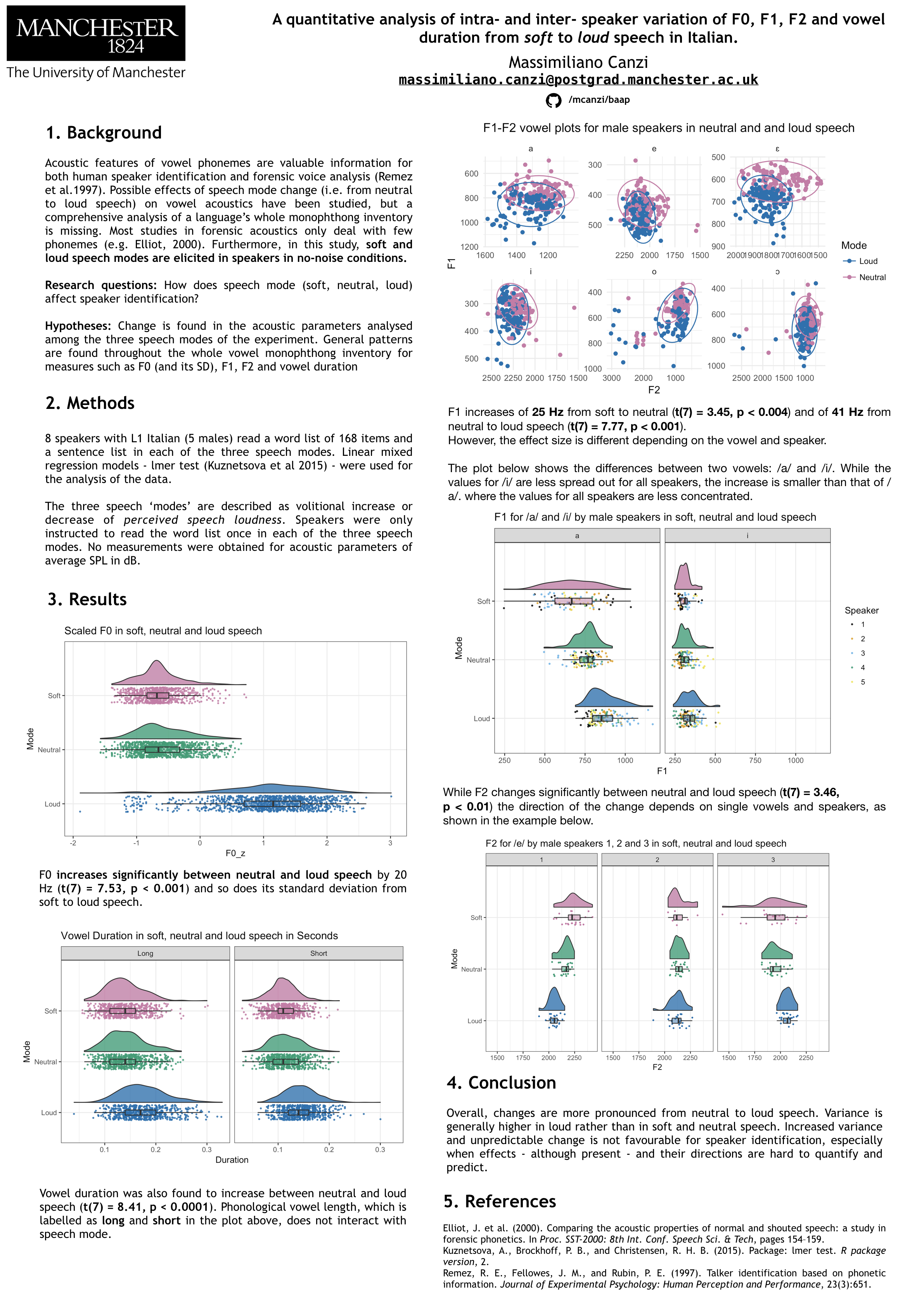Inter- and intra- speaker variation of F(0, 1, 2) & vowel duration in soft, neutral and loud speech in Italian {M Canzi}
April 11, 2018 - 3 minutes
acoustics phonetics productionOutput
-
(2018) Canzi, M. The Forensic implications of comparing soft, neutral and loud speech. Talk presented at the Manchester Forum in Linguistics (mFiL) at The University of Manchester
-
(2018) Canzi, M A quantitative analysis of inter- and intra- speaker variation of F0, F1, F2 and vowel duration in soft, neutral and loud speech in Italian. Poster presented at the British Association of Academics in Phonetics (BAAP) at the University of Kent.
Abstract
The current research focuses on the variation of acoustic and phonetic parameters including mean F0, F1, F2, speech rate and vowel duration in soft, neutral and loud speech throughout the whole Italian vowel monophthong inventory. Considerable intra–speaker variation from soft to loud speech is expected. Furthermore, we expect considerable inter-speaker variation to be conditioned by speech mode. Both inter- vs –intra-speaker differences are considered extremely relevant in the forensic context, as they are known to play a role in speaker identification and recognition (Remez et al. 1997). The study presents a bigger picture of the effect of speech-mode change throughout a whole vowel inventory, compared to existing studies on forensic phonetic analysis of loud speech which mainly focused on one or few vowels (e.g. Elliot 2000).
8 speakers with L1 Italian (5 males) read a word list of 168 items and a sentence list in each of the three speech modes. Results of linear mixed effects model regressions (lmerTest; Kuznetsova et al. 2015) show significant difference (20 Hz) for mean F0 (t(7) = 7.53, p < 0.001) and F2 from neutral to loud speech only (t(7) = 3.46, p < 0.01). No stable trend can be discerned for a change in F2, in contrast, F1 is found to increase of 25.5 Hz from soft to neutral (t(7) = 3.45, p < 0.004) and of 41.1 Hz from neutral to loud speech (t(7) = 7.77, p < 0.001). Speech rate, measured in syllables per second, decreases around 10% from neutral to loud speech (8 SpS in neutral speech, 7.1 in loud) but it does not show significant difference between soft and neutral speech. Vowel length was found to increase between neutral and loud speech (t(7) = 8.41, p < 0.0001), but it remains unchanged between soft and neutral. There was no significant interaction between phonological vowel length and speech mode in conditioning pitch and formant increase.
Differences in production and acoustics between speech modes, from soft to loud speech in this particular case, have both been attributed to production demands and perceptual constraints (Schulman 1989). Inter-speaker’s standard deviation for mean formant frequencies, for each of the seven vowel monophthongs, was found to be higher in loud and soft speech rather than in neutral, which suggests that the first two formants can be better used for differentiating speakers, both in acoustic analysis and in human perception and identification, when the speech mode is altered from neutral.
Poster

Resources
You can find the research compendium (including data, analysis, code and slides/poster) for this project at the following links: